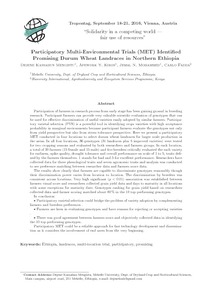Participatory Multi-Environmental Trials (MET) identified promising durum wheat landraces in Northern Ethiopia
Abstract
Participation of farmers in research process from early stage has been gaining ground in breeding research. Participant farmers can provide very valuable scientific evaluation of genotypes that can be used for effective discrimination of useful varieties easily adopted by similar farmers. Participatory varietal selection (PVS) is a powerful tool in identifying crops varieties with high acceptance probability in marginal environments because participant farmers evaluate the genotypes not only from yield perspective but also from stress tolerance perspective. Here we present a participatory MET conducted in four locations to select durum wheat landraces for larger scale production in the areas. In all four locations, 36 genotypes (31 landraces plus 5 improved varieties) were tested for two cropping seasons and evaluated by both researchers and farmers groups. In each location, a total of 30 farmers (15 female and 15 male) and five breeders critically evaluated the each variety for earliness, spike quality, drought tolerance and overall performance on scale of 1 to 5, traits defined by the farmers themselves. 1 stands for bad and 5 for excellent performance. Researchers have collected data for three phenological traits and seven agronomic traits and analysis was conducted to see preference matching between researcher data and farmers score data.
The results show clearly that farmers are capable to discriminate genotypes reasonably though their discrimination power varies from location to location. The discrimination by breeders was consistent across locations. Very high significant (p<0.01) association was established between farmers visual score and researchers collected grain yield data and days to maturity in all locations with some exceptions for maturity date. Genotypes ranking for grain yield based on researchers collected data and farmer scoring matched about 80% in the 10 top performing genotypes.
In conclusion:
· Participatory varietal selection could bridge the problem of variety adoption by complementing farmers and breeders preferences .
· Farmers are keen in evaluating genotypes and have reasons for rejecting or accepting varieties .
· There was good agreement between farmers score and objectively collected data in identifying the 10 top performing genotypes.
Participatory MET could be a reliable approach for fast technology development and dissemination as it considers the involvement of end users from the very beginning.

